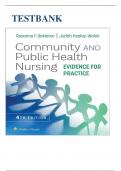TESTBANK
,TABLEOFCONTENTS
,CHAPTER1:PublicHealth Nursing J
1. AJnurse is striving to practice patient-
centered care atJa hospital. Which action bestexemplifies providing patient-
centered care?
A) HavingJa clientJcomplete aJself-
reported functional status indicator and thenreviewingJit with the client
B) Explaining toJaJclientJthe benefits of computer-
assisted robotic surgicaltechniques, which the hospital recently implement
ed
C) RecordingJa client's signs and symptoms in an electronicJhealth record
D) PerformingJcontinuous glucose monitoring of aJclientJwhile the clientJis in thehosp
ital
ANSWER:J A
RATIONALE:
Patient-
centered care considers cultural traditions, personal preferences, values, families, and lifestyl
es. Clients become active participants in their own care, and monitoring health becomesJthe c
lient'sJresponsibility. To help clients and their healthcare providers make better decisions, th
e Agency for Healthcare Research and Quality (AHRQ) has developed a series of tools that e
mpower clients and assistJproviders in achieving desired outcomes, includingJclient- reported
functional status indicators. Computer-
assisted robotic surgical techniques, electronicJhealth records, andcontinuousJglucose monit
oring in the hospital are all technological advances in healthcare, but they do not helpJthe clie
ntJbecome a more active participant in his or hercare, and thus are not good examples of patie
nt-centered care.
Origin: CHAPTER 1-JPublic Health Nursing, 2
2. A nurse is caring for an older client who is strugglingJtoJmanage her type 2 diabetesJmellitus.
The nurse should recognize which social determinantsJof this client'sJhealth?(SelectJ allJthat
apply.)
, A) Household income of$23,000 per year
B) Reading level ofa third grader
C) Medication ineffective due toJerror in prescription
D) Originally from Sudan
E) No family in the area
ANSWER:J A, B, D, E Fee
dback:
The social conditions in whichJpeople live, their income, social status, education, literacy, ho
me and workenvironment, support networks, gender, culture, and availability of health servi
ces are the social determinants of health. These conditionsJhave an impact on the extent to w
hich a person or community possesses the physical, social, and personalresourcesnecessary
toJattain and maintain health. AJmedical erroronJthe partJof the client's primary care provider
or nurse would not constitute a social determinant of the client's health.
3. Anurse successfully persuades anobese client to performa weeklyweigh-
in at homeusing a digital scale and record the weightJ inJaJlog. This strategy is an example of:
A) Telehealth
B) Health information technology
C) Personalresponsibility for health
D) Evidence-
basednursingA
J NSWER: C
RATIONALE:
Personal responsibility for health involvesJactive participation in one's own health through ed
ucation and lifestyle changes. In this case, the clientJmakes aJpositive changein lifestyle by mo
nitoring body weight weekly. Telehealth is the use of electronic information and telecommu
nications technologies to support long-
distance clinical healthcare, client and professional health-
related education, publicJhealth, and health administration. HealthJinformation technology (
HIT) is defined as the comprehensive managementJof health information and itsJexchange b
etween consumers, providers, government, and insurers inJaJsecure manner. Evidence-
based nursing is the integrationof the best evidence available with clinical expertise and the va
lues of the client to increase the quality ofcare.
PageJ 3




